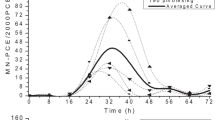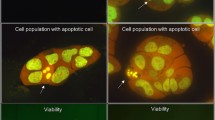Abstract
The cytotoxic and mutagenic effect of the bifunctional alkylating agent nitrogen mustard (HN2) was examined. Primary human lymphocytes were exposed to graded doses of HN2 in vitro and relative survival was determined. Mutation induction at the hypoxanthine-guanine phosphoribosyltransferase (hprt) locus was measured by cloning the exposed T-cells in microtitre plates in the presence and absence of 6-thioguanine (TG). The IC50-value determined for 30 min exposure to HN2 was 1.34 μM. The mutant frequencies (MF) in exposed T-cell cultures were 10-fold (2 μM HN2) to 32-fold (4 μM HN2) higher than those of unexposed cultures (median values). Nitrogen mustard-mediated mutagenesis is discussed in terms of the current ideas about DNA damage and repair.
Similar content being viewed by others
Author information
Authors and Affiliations
Additional information
Received: 14 May 1996 / Accepted: 28 August 1996
Rights and permissions
About this article
Cite this article
Olsen, L., Korsholm, B., Nexø, B. et al. Nitrogen mustard-mediated mutagenesis in human T-lymphocytes in vitro. Arch Toxicol 71, 198–201 (1997). https://doi.org/10.1007/s002040050376
Issue Date:
DOI: https://doi.org/10.1007/s002040050376




